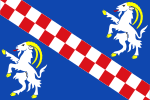Cabranes
Cabranes | |
|---|---|
 Torazu, Cabranes | |
 | |
| Coordinates: 43°25′N 5°24′W / 43.417°N 5.400°W | |
| Country | |
| Autonomous community | |
| Province | Asturias |
| Comarca | Oviedo |
| Judicial district | Piloña |
| Capital | Santolaya |
| Government | |
| • Alcalde | Gerardo Fabián Fernández (PSOE) |
| Area | |
| • Total | 38.31 km2 (14.79 sq mi) |
| Highest elevation | 581 m (1,906 ft) |
| Population (2023) | |
| • Total | 1,105 |
| • Density | 29/km2 (75/sq mi) |
| Demonym | cabraniego/a |
| Time zone | UTC+1 (CET) |
| • Summer (DST) | UTC+2 (CEST) |
| Postal code | 33310 |
Cabranes is a municipality in the autonomous community of Asturias. As of 2023, it had a population of 1,105[1] spread between its six parishes: Fresnéu, Graméu, Pandenes, Santolaya, Torazu, and Viñón. Cabranes has a rugged, yet not mountainous, terrain, with its economy focused on cattle and apple farming.[2] At just over 38 km2 in area, the municipality is among the smallest in Asturias.[2]
History
[edit]There is little mention of Cabranes in written history until the 13th century, although archeological vestiges prove inhabitance of the area before that time. The construction of the monastery of Valdedios was a notable event during the period; the municipality as a whole continued to remain relatively unnoteworthy due to its rural nature. Cabranes developed a large monastic population in the following centuries. Ultimately, the municipality failed to modernize significantly throughout its existence, and the municipality was mostly unaffected by major occurrences in Spain, such as the Civil War. Cabranes has suffered from a continuously declining population due to emigration and an aging population, similarly to many other municipalities in Asturias.[2][3]
Art
[edit]Due to the municipality's historically high number of "Indianos," or Spaniards who emigrated to Latin America and later returned, there is a rich and diverse civil architecture. Notable among the buildings are the schools of Viñón and Santolaya and the chalet of Alfonso San Feliz. There are also many religious buildings in the region, such as the church of San Julián de Viñon, which displays a combination of Pre-Roman Asturian and Romanesque architecture. The parish church of Santa Eulalia, from the 15th century, and the church of San Martín el Real, in a mannerist style, are also noteworthy.[2]
Politics
[edit]The current mayor is Gerardo Fabián Fernández (FSA-PSOE).[4]
Local elections
| ||||||||||
| Party/List | 1979 | 1983 | 1987[5] | 1991[5] | 1995[5] | 1999[5] | 2003[5] | 2007[5] | 2011[6] | 2015[7] |
| FSA-PSOE | 3 | 4 | 2 | 4 | 3 | 3 | 6 | 8 | 8 | 7 |
| CD / AP / PP | 0 | 7 | 7 | 5 | 6 | 4 | 2 | 1 | 0 | 1 |
| UCD / CDS | 8 | 0 | 0 | |||||||
| URAS | 2 | 1 | ||||||||
| FAC | 1 | 1 | ||||||||
| Total | 11 | 11 | 9 | 9 | 9 | 9 | 9 | 9 | 9 | |
References
[edit]- ^ "Nomenclátor: Población del Padrón Continuo por Unidad Poblacional a 1 de enero". Instituto Nacional de Estadística (in Spanish). 2023. Retrieved 17 June 2024.
- ^ a b c d "Cabranes". Federación Asturiana de Concejos (in Spanish). Retrieved 17 June 2024.
- ^ Villa, Octavio (1 May 2022). "Setenta concejos pierden población de forma continua en el último cuarto de siglo". El Comercio (in Spanish). Retrieved 17 June 2024.
- ^ "Bienvenida institucional". Ayuntamiento de Cabranes (in Spanish). Retrieved 17 June 2024.
- ^ a b c d e f Dirección General de Política interior
- ^ Elecciones Locales 2011
- ^ Elecciones Locales 2015
External links
[edit]- Ayuntamiento de Cabranes (in Spanish)



